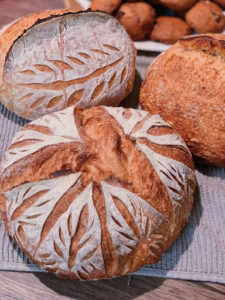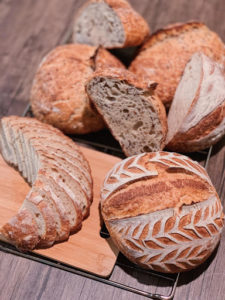7 Reasons to Switch to Homemade Sourdough Bread
go.ncsu.edu/readext?718755
en Español / em Português
El inglés es el idioma de control de esta página. En la medida en que haya algún conflicto entre la traducción al inglés y la traducción, el inglés prevalece.
Al hacer clic en el enlace de traducción se activa un servicio de traducción gratuito para convertir la página al español. Al igual que con cualquier traducción por Internet, la conversión no es sensible al contexto y puede que no traduzca el texto en su significado original. NC State Extension no garantiza la exactitud del texto traducido. Por favor, tenga en cuenta que algunas aplicaciones y/o servicios pueden no funcionar como se espera cuando se traducen.
Português
Inglês é o idioma de controle desta página. Na medida que haja algum conflito entre o texto original em Inglês e a tradução, o Inglês prevalece.
Ao clicar no link de tradução, um serviço gratuito de tradução será ativado para converter a página para o Português. Como em qualquer tradução pela internet, a conversão não é sensivel ao contexto e pode não ocorrer a tradução para o significado orginal. O serviço de Extensão da Carolina do Norte (NC State Extension) não garante a exatidão do texto traduzido. Por favor, observe que algumas funções ou serviços podem não funcionar como esperado após a tradução.
English
English is the controlling language of this page. To the extent there is any conflict between the English text and the translation, English controls.
Clicking on the translation link activates a free translation service to convert the page to Spanish. As with any Internet translation, the conversion is not context-sensitive and may not translate the text to its original meaning. NC State Extension does not guarantee the accuracy of the translated text. Please note that some applications and/or services may not function as expected when translated.
Collapse ▲The quarantine revealed an interesting trend worldwide. Our society seemed to have divided into those who languish from absolute boredom, sitting within the four walls of their rooms, and those who acquired an intense boost of creativity in isolation as never before. Many perceived the forced sitting at home as a unique and, perhaps, the only chance to accomplish what they have always dreamed of, but never found time to do.
In principle, this phenomenon is nothing new. There are many examples in history of how incredible discoveries and creative take-offs occurred due to forced seclusion of many great people. For example, during the cholera epidemic in the fall of 1830, Alexander Pushkin self-quarantined at the estate of Bolshoye Boldino. Far from profane communication and forced to be alone for a long time, he wrote all of the best works that glorified him over the centuries.
The modern quarantine has been a fruitful time for numerous people. During the quarantine, many began to cook more and, most importantly, to bake. Photos of cookies, cakes, and pies flooded all social media platforms. One of the most popular baked goods appearing in everyone’s news feeds was a simple homemade bread baked by the principles of the ancient times – using leaven, no industrial yeast, and no bread maker.
My mother was first to introduce me to the art of bread baking. She came to visit me from Ukraine and had to stay for several months because of the quarantine. She has been baking homemade sourdough bread for almost two years now, so my apartment turned into a real bakery during her visit. My mother learned the bread baking mastery from the great bakers in Barcelona, Spain, whose leaven is over 100 years old. You might ask, what is leaven?
Before we jump into all the miracles of homemade sourdough bread, we need to know where all these benefits come from. Simply put, leaven is the sourdough bread starter. You cannot make sourdough bread without it. The starter itself is a symbiosis of lactic acid bacteria and wild yeast in the form of colonies that feed on flour and water. It is responsible for fermentation and dough expansion. Before it is ready for bread baking, the leaven must be “fed” and “grown,” changing 3/4 of its composition daily. The wild yeast can be found everywhere in the environment. Thus, leaven can be derived from anything natural: hop cones, raisins, grapes, apple peels, fig-trees, whole-grain rye, and wheat flour.
People have used leaven to raise dough since the beginning of time. It is believed that the ancient Egyptians made the very first leavened bread at the banks of the Nile River around 1500 BC. The bread leaven in Russia was traditionally derived from rye flour, straw, barley, wheat, and hops. In remote villages, far from the “blessings” of civilization, you can still find the recipes of traditional bread baking from the end of the 19th century.
The cycle of the bread dough made with industrial yeast lasts no more than 3-4 hours, while leavened dough – about 12 hours. The process of making sourdough bread is much longer and more expensive. That is why almost all manufacturers nowadays bake bread with artificial industrial yeast; it is cheaper and easier to “survive” in our modern competitive market. Bread loses all its nutritional value with this type of yeast and promotes weight gain.
How exactly is homemade sourdough bread better than the bread you see in all the grocery stores?
1. Low Glycemic Index
Long-term fermentation of the sourdough results in bread that digests slower having little to no effect on a person’s blood sugar.
The cycle of the sourdough is at least twice as long as that of the industrial yeast dough. During the cycle, the processes of partial decomposition of flour components occur under the influence of leaven. These processes are very similar to those that occur in our digestive tract. As a result, the bread we consume consists of partially “digested” proteins, split into amino acids, peptones, and polypeptides.
There is also the processing of flour carbohydrates into di- and monosaccharides, carbon dioxide, and other volatile gases, such as alcohols, all of which relieve unnecessary stress from the human digestive tract. Besides, flour fats are broken down into fat-soluble acids, which are much easier to digest.
All of the above are undeniable benefits of the homemade sourdough bread, especially for those trying to control their weight and blood sugar levels.
2. Vitamins & Minerals
Prolonged fermentation of sourdough contributes to a significant nutritional and taste transformation. It makes bread not only tasty but also increases the bioavailability of most vitamins, minerals, and antioxidants of the flour.
The sources of all B-complex vitamins and vitamin E are the unprocessed rye or whole wheat seeds themselves. They also contain minerals, such as Magnesium, Potassium, Iron, Zinc, and Calcium in significant quantities. It is worth mentioning that rye flour contains 30% more iron than whole wheat flour and twice the amount of magnesium and potassium.
3. Fiber & Probiotic
Fermentation makes noticeable changes in the flour, which makes bread not only more nutritious for us but also the microbes in our gut. The health benefits of whole grain sourdough bread lie in the abundance of fiber, which is the primary food of our healthy microflora. The creation of numerous specific types of fiber, foods, and nutrients makes the starter culture a probiotic. Probiotics are foods for our beneficial bacteria in the gut; they help them multiply and thrive as they are essential to our health.
4. Gluten Tolerance
Gluten contains the indigestible amino acids – proline and glutamine – which cause allergies among many people. However, through prolonged fermentation, lactobacilli break down these proteins, making the bread safe for many celiac patients (those with gluten intolerance).
However, if you have a gluten intolerance, beware of the environment where the bread is made and whether additional flour is added on the outside of the bread.
5. Protein
Leavened bread contains a higher amount of protein than other types of bread. As a result, protein, which is one of the primary essential nutrients, helps to regenerate cells in the body. What’s more, it promotes muscle building and recovery.
6. Pesticide Safety
Leaven introduces additional friendly microorganisms into the bread that ferment the dough and destroy some of the pesticides that can be found in regular flour. Thus, it is always good to buy organic flour to avoid putting your body at risk.
7. Aroma & Flavor
Homemade sourdough bread brings out the aroma and flavor of the grains more vividly through the fermentation process. The bread is so deep in taste that you would not even want to put anything extra on it.
How to differentiate?
You can distinguish sourdough bread from ordinary yeast bread by the crumb, which is the soft, inner part of the bread. Real sourdough bread has large, uneven holes on the inside. Due to the high content of gluten in the industrial yeast bread, its bubbles are small and uniform. However, the exception here is rye bread, which is naturally low in gluten. Its crumb has a moist structure with fine pores and pleasant sourness.
Easy Recipe of Leaven for Beginners
from my mother [Julia Litvinova]
Ingredients
- A handful of patience
- Glass jar
- Rubber spatula
- Filtered water
- Rye flour (or Whole Wheat flour)
Directions
Day 1
- Using a rubber spatula, mix 45g of flour & 30g of water in a glass jar.
- Close lid loosely to allow Oxygen in.
- Store in a warm place (at about 80F) for 24 hours – you can leave it on your kitchen table, but make sure your house is not cold!
Day 2
- Today you will see more volume in the jar, bubbles will appear, and you will notice a bad smell.
- Add 30g of flour & 45g of water to the jar.
- Mix well with the spatula.
- Close the lid loosely.
- Store at 80F for 24 hours.
Day 3
- The volume should double now, you will see bubbles, and notice a bad smell.
- Now, take 20g from the starter (the rest goes to trash).
- Add 20g water & 20g flour (1:1:1 ratio).
- Mix well with the spatula.
- Close lid loosely.
- Again, store at 80F for 24 hours.
Day 4
- Repeat the steps from Day 3.
Day 5
- Almost there!
- Now, you will have to start feeding the starter twice a day (morning and evening). Do not forget!
- Take 20g of the starter.
- Add 20g of water & 20g of flour (1:1:1 ratio).
Day 6 & Day 7
- Our starter is ready but follow the steps from Day 5 for 2 more days because we want the starter to get stronger.
Day 8
- Our sourdough starter is ready for baking! You will have to continue feeding the starter twice a day with the ratio of 1:2:2 (for example, you take 5 g of the starter + 10 g of flour + 10 g of water)
After a few days, you can increase that ratio to 1:3:3 or even 1:4:4 if your starter reaches its peak before 12 hours. If it falls down, it means it’s hungry!
I never cease to be convinced of one simple truth – all the best on earth is created by nature. Human’s attempts to surpass nature are not always crowned with success. We created yeast, opted for convenience and speed of baking, sacrificing all the medicinal properties of bread. I believe that returning to the centuries-old traditions of fermenting bread may help people overcome many modern diseases and maintain health.
Stay healthy!
This article was written by our outstanding 2020 N.C. Cooperative Extension of Catawba County Nutrition and Health Intern Valeriia Litvinova (not written by George – he has no bread-making skills or knowledge!).








